外研版(2019)选择性必修四 Unit Into the unknown Diving Deep 课件(共27张PPT)
文档属性
| 名称 | 外研版(2019)选择性必修四 Unit Into the unknown Diving Deep 课件(共27张PPT) | 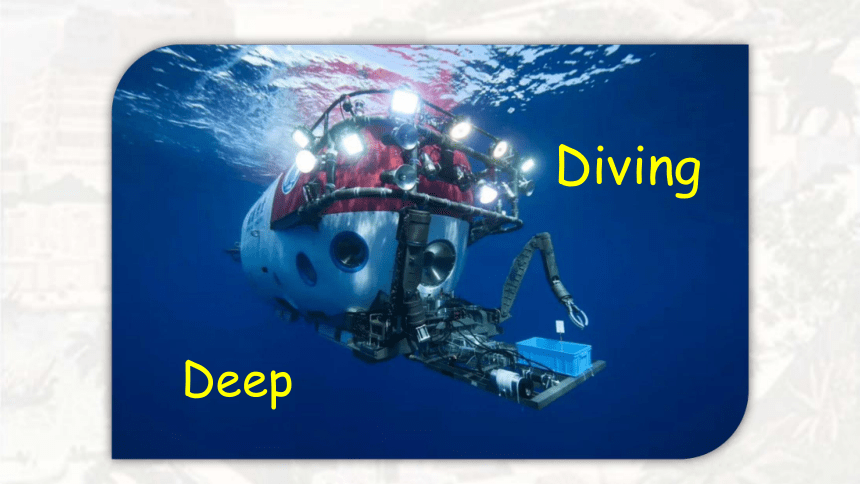 | |
| 格式 | pptx | ||
| 文件大小 | 9.8MB | ||
| 资源类型 | 教案 | ||
| 版本资源 | 外研版(2019) | ||
| 科目 | 英语 | ||
| 更新时间 | 2023-05-23 18:31:55 | ||
图片预览

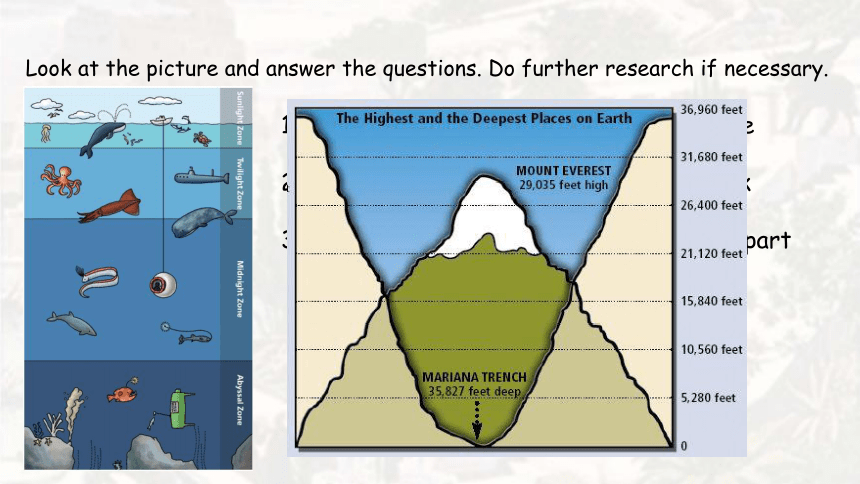
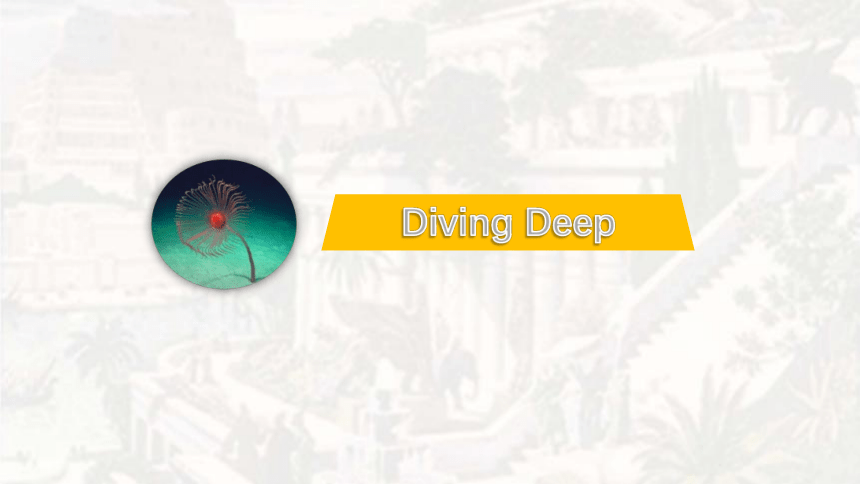

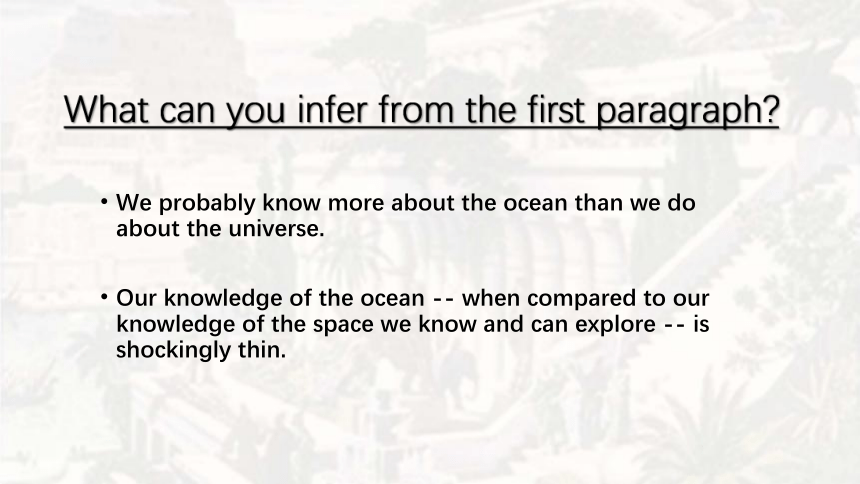
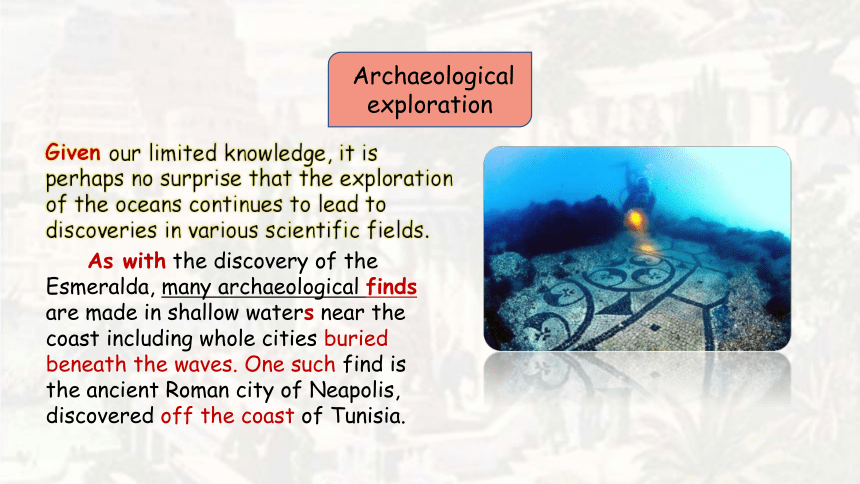

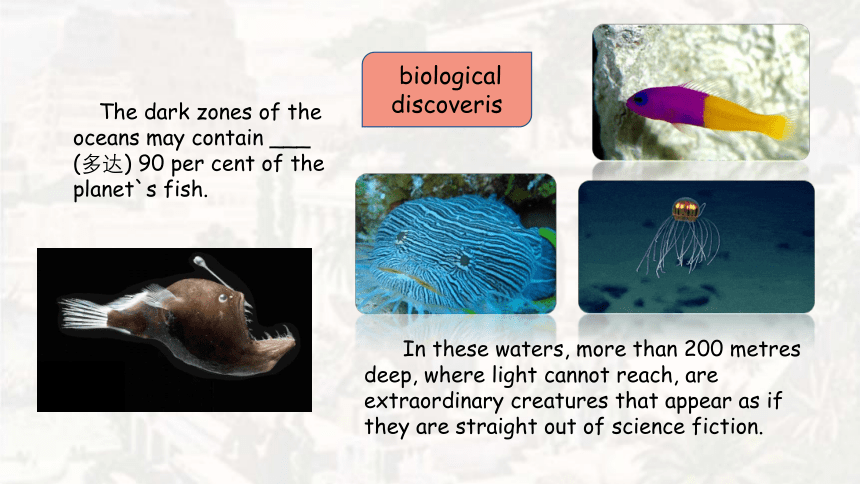

文档简介
(共27张PPT)
Diving
Deep
Look at the picture and answer the questions. Do further research if necessary.
What different zones are there in the ocean
Which parts of the ocean do you think have been explored
What do you know about the deepest part of the ocean
The different zones in the ocean are Sunlight Zone, Twilight Zone, Midnight Zone and Abyssal Zone.
Diving Deep
Ocean exploration
Lying under waters across the globe are an estimated three million shipwrecks. All of them represent attempts over the centuries to explore Earth`s furthest corners.
Among these is the Esmeralda, the earliest wreck from the age of the European exploration of Asia.
Today, some 500 years after the Esmeralda set sail, there is little-if any-land on our planet left unexplored. We have more detailed maps of the Moon and even of Venus and Mars, than we do of Earth’s own sea bed.
What can you infer from the first paragraph
We probably know more about the ocean than we do about the universe.
Our knowledge of the ocean -- when compared to our knowledge of the space we know and can explore -- is shockingly thin.
Archaeological exploration
As with the discovery of the Esmeralda, many archaeological finds are made in shallow waters near the coast including whole cities buried beneath the waves. One such find is the ancient Roman city of Neapolis, discovered off the coast of Tunisia.
Given our limited knowledge, it is perhaps no surprise that the exploration of the oceans continues to lead to discoveries in various scientific fields.
Believed to have been buried underwater by a tsunami in the fourth century AD, the ruins of Neapolis are almost 2000 years old. The remaining streets and buildings offer a window into a fascinating period in our history.
However, we are only beginning to overcome the challenges of pressure, darkness and extreme cold at vast depths. Fragments of the past lying deep beneath the oceans are still waiting to be discovered.
biological discoveris
In these waters, more than 200 metres deep, where light cannot reach, are extraordinary creatures that appear as if they are straight out of science fiction.
The dark zones of the oceans may contain ___ (多达) 90 per cent of the planet`s fish.
Imagine bone-white coral 6000 metres below the ocean`s surface, growing at the rate of only one or two millimetres per year.
Some of these could be 4000 years old .
Swimming through these black depths is the barreleye, a strange fish with eyes that can look upwards through its transparent forehead.
In the very deepest ocean trenches that are more than 8000 metres below the surface, the pressure is equivalent to 50 aeroplanes stacked one on top of another. Yet there is still life to be found, even around the deep-sea volcanic openings. These discoveries all help us understand the capacity for life on our planet, even in the most extreme circumstances.
庞贝蠕虫
海葵
Furthermore, the oceans are a valuable source of natural resources, some of ____ are completely new to us. Most notable of these is China`s discovery of an ice-like substance, known as “fire ice”, under the South China Sea.
Discovery of
natural resources
In addition, China’s underwater vessels, such as the Jiaolong and Shenhai Yongshi, have been exploring waters at depths of thousands of metres. The Jiaolong even holds the record for the deepest dive by a manned submarine, at
7, 062 metres, giving China its place alongside the world’s top ocean explorers.
The research conducted by these vessels is giving scientists a greater understanding of how the sea bed was formed, as well as ____ (help) identify areas for deep-sea drilling, taking deep-sea exploration into a whole new era.
Being a tough environment of complete darkness, enormous pressure and intense cold, the ocean depths have long been beyond the reach of human exploration. However, through closer international scientific, economic and cultural cooperation, we are all becoming part of a global mission to open up our planet`s final frontier.
A new age of oceanic discovery
Humankind is entering a new age of oceanic discovery, and the world beneath the waves may one day be almost as familiar to us as the land we walk upon today.
Nowadays, we have been exploring oceans and made great achievements. As 1________ the discovery of the Esmeralda, many archaeological finds are made in shallow waters near the coast, one of 2________ is the ancient Roman city of Neapolis. 3_________(believe) to have been buried underwater by a tsunami in the fourth century AD, the ruins are almost 2000 years old. The 4__________(remain) streets and buildings offer a window into a fascinating period in our history.
Amazing biological discoveries are also being made. Extraordinary creatures are living more than 200 metres deep into the ocean, 5_______ light can`t reach. Even in the very deepest ocean trenches that are more than 8000 metres below the surface, there is still life 6____________(find).
with
which
Believed
remaining
where
to be found
直击高考
Besides, the oceans are a valuable source of natural resources, most notable of which is China`s discovery of 7__________ ice-like substance, known as “fire ice” . In addition, China`s underwater vessels have been exploring waters at 8___________(deep) of thousands of metres.
The Jiaolong even holds the record for the deepest dive by a manned submarine , at 7062 metres, 9__________(give) China its place alongside the world`s top ocean explorers.
Despite many challenges, through closer international cooperation, the world beneath the waves may one day be almost 10__________ familiar to us as the land we walk upon today.
an
depths
giving
as
Why do you think the author uses statistics in the passage
2 What common message do the two reading passages in this unit convey How do they each build upon this idea
The use of statistics makes the passage more convincing.
Both passages convey the message that humans have the desire and means to explore the unknown.
The first passage does this by looking at our fascination with history’s greatest mysteries, while the second passage looks at pioneering exploration of Earth’s oceans.
Think & Share
1 About what time did the Esmeralda set sail
A In 1920. B In 1520. C In 1820. D In 1620.
2 What caused the ancient Roman city of Neapolis to be buried underwater according to the passage
A A terrible earthquake.
B A volcanic eruption.
C A tsunami.
D A hurricane.
3 According to the biological discoveries, which of the following is right
A Most of the planet`s fish live deep into the ocean.
B Creatures can`t live without light.
C Bone-white coral grows fast below the ocean`s surface.
D There is no life around the deep-sea volcanic openings.
Reading comprehension
4 Which of the achievements makes China the world`s top ocean explorers
A The discovery of “fire ice”.
B The discovery of the ruins of Neapolis.
C The discovery of the Esmeralda.
D China`s vessel, Jiaolong, holds the record for the deepest dive by a manned submarine.
5 What`s the author`s attitude towards ocean exploration
A Unfavourable.
B Negative.
C Too challenging.
D Supportive.
Look at the diagram below and brainstorm examples of how ocean exploration affects your daily life.
Organise your talk by completing the diagram with your examples.
Give your talk to the class.
Now think about how well you contributed to the
Group work and what you could do to improve.
Give a talk about the influences of ocean exploration on your daily life.
Writing about
the unexplained
Why is the 30th parallel north mysterious
What are some unusual explanations for it
What are some possible scientific explanations
Along a special line of latitude, known as the 30th parallel north, lie numerous sites of ancient civilisations and impressive natural features.
Ancient civilisations appeared on the parallel, including Babylon , with its famous tower; Egypt, with its pyramids; China, with its Sanxingdui culture, etc. These civilisations appeared at a similar time, and all developed advanced bronze-making techniques. Were they part of a single super-civilisation, as some think
It`s argued that the 30th parallel north is a line of great natural energy, with frequent earthquakes and volcanic eruptions. This creates amazing natural features, including Mount Qomolangma, the Dead Sea, and rivers, such as the Nile, the Mississippi and the Yangtze. Lacking any concrete evidence, some even claim it was supernatural powers!
Scientists, however, dispute these theories. It`s more likely, they argue, that civilisations arose on the 30th parallel north because the climate there is generally warm and wet. Major tectonic plates meet at this latitude, causing earthquakes, which helped form the Himalayas. The rest, they say, is either coincidence or fantasy.
A long line of mysteries
The 30th parallel north is mysterious because it is where numerous sites of ancient civilisations and impressive natural features lie.
Some believe that the 30th parallel north is a line of great natural energy, with frequent earthquakes and volcanic eruptions, and others even claim that its amazing natural features were caused by supernatural powers.
Possible scientific explanations for the 30th parallel north include the generally warm and wet climate that made it a good place for civilisations to develop, and the fact that it is where major tectonic plates meet.
What is the unexplained phenomenon
Why is it mysterious
What non-scientific explanations are there
How do scientists explain it
Plan an article about an unexplained phenomenon.
Do further research if necessary.
The Bermuda Triangle
Far below the surface of the North Atlantic Ocean, in a roughly triangular area known as the Bermuda Triangle, lie more than 50 shipwrecks and 20 plane wrecks. What makes these wrecks so mysterious is that the cause of their fate remains largely unknown – ships were abandoned without apparent reason, distress signals were never sent and aircraft were lost without trace.
Some believe that supernatural forces are responsible, while others put the accidents and disappearances down to coincidence. Scientific theories, meanwhile, include pilot error when trying to navigate the area, and huge “rogue waves” caused by terrible storms.
Although many ships and planes cross the Bermuda Triangle without incident, the stories behind those doomed vessels’ fates continue to capture people’s imaginations.
Explore into the unknown
Diving
Deep
Look at the picture and answer the questions. Do further research if necessary.
What different zones are there in the ocean
Which parts of the ocean do you think have been explored
What do you know about the deepest part of the ocean
The different zones in the ocean are Sunlight Zone, Twilight Zone, Midnight Zone and Abyssal Zone.
Diving Deep
Ocean exploration
Lying under waters across the globe are an estimated three million shipwrecks. All of them represent attempts over the centuries to explore Earth`s furthest corners.
Among these is the Esmeralda, the earliest wreck from the age of the European exploration of Asia.
Today, some 500 years after the Esmeralda set sail, there is little-if any-land on our planet left unexplored. We have more detailed maps of the Moon and even of Venus and Mars, than we do of Earth’s own sea bed.
What can you infer from the first paragraph
We probably know more about the ocean than we do about the universe.
Our knowledge of the ocean -- when compared to our knowledge of the space we know and can explore -- is shockingly thin.
Archaeological exploration
As with the discovery of the Esmeralda, many archaeological finds are made in shallow waters near the coast including whole cities buried beneath the waves. One such find is the ancient Roman city of Neapolis, discovered off the coast of Tunisia.
Given our limited knowledge, it is perhaps no surprise that the exploration of the oceans continues to lead to discoveries in various scientific fields.
Believed to have been buried underwater by a tsunami in the fourth century AD, the ruins of Neapolis are almost 2000 years old. The remaining streets and buildings offer a window into a fascinating period in our history.
However, we are only beginning to overcome the challenges of pressure, darkness and extreme cold at vast depths. Fragments of the past lying deep beneath the oceans are still waiting to be discovered.
biological discoveris
In these waters, more than 200 metres deep, where light cannot reach, are extraordinary creatures that appear as if they are straight out of science fiction.
The dark zones of the oceans may contain ___ (多达) 90 per cent of the planet`s fish.
Imagine bone-white coral 6000 metres below the ocean`s surface, growing at the rate of only one or two millimetres per year.
Some of these could be 4000 years old .
Swimming through these black depths is the barreleye, a strange fish with eyes that can look upwards through its transparent forehead.
In the very deepest ocean trenches that are more than 8000 metres below the surface, the pressure is equivalent to 50 aeroplanes stacked one on top of another. Yet there is still life to be found, even around the deep-sea volcanic openings. These discoveries all help us understand the capacity for life on our planet, even in the most extreme circumstances.
庞贝蠕虫
海葵
Furthermore, the oceans are a valuable source of natural resources, some of ____ are completely new to us. Most notable of these is China`s discovery of an ice-like substance, known as “fire ice”, under the South China Sea.
Discovery of
natural resources
In addition, China’s underwater vessels, such as the Jiaolong and Shenhai Yongshi, have been exploring waters at depths of thousands of metres. The Jiaolong even holds the record for the deepest dive by a manned submarine, at
7, 062 metres, giving China its place alongside the world’s top ocean explorers.
The research conducted by these vessels is giving scientists a greater understanding of how the sea bed was formed, as well as ____ (help) identify areas for deep-sea drilling, taking deep-sea exploration into a whole new era.
Being a tough environment of complete darkness, enormous pressure and intense cold, the ocean depths have long been beyond the reach of human exploration. However, through closer international scientific, economic and cultural cooperation, we are all becoming part of a global mission to open up our planet`s final frontier.
A new age of oceanic discovery
Humankind is entering a new age of oceanic discovery, and the world beneath the waves may one day be almost as familiar to us as the land we walk upon today.
Nowadays, we have been exploring oceans and made great achievements. As 1________ the discovery of the Esmeralda, many archaeological finds are made in shallow waters near the coast, one of 2________ is the ancient Roman city of Neapolis. 3_________(believe) to have been buried underwater by a tsunami in the fourth century AD, the ruins are almost 2000 years old. The 4__________(remain) streets and buildings offer a window into a fascinating period in our history.
Amazing biological discoveries are also being made. Extraordinary creatures are living more than 200 metres deep into the ocean, 5_______ light can`t reach. Even in the very deepest ocean trenches that are more than 8000 metres below the surface, there is still life 6____________(find).
with
which
Believed
remaining
where
to be found
直击高考
Besides, the oceans are a valuable source of natural resources, most notable of which is China`s discovery of 7__________ ice-like substance, known as “fire ice” . In addition, China`s underwater vessels have been exploring waters at 8___________(deep) of thousands of metres.
The Jiaolong even holds the record for the deepest dive by a manned submarine , at 7062 metres, 9__________(give) China its place alongside the world`s top ocean explorers.
Despite many challenges, through closer international cooperation, the world beneath the waves may one day be almost 10__________ familiar to us as the land we walk upon today.
an
depths
giving
as
Why do you think the author uses statistics in the passage
2 What common message do the two reading passages in this unit convey How do they each build upon this idea
The use of statistics makes the passage more convincing.
Both passages convey the message that humans have the desire and means to explore the unknown.
The first passage does this by looking at our fascination with history’s greatest mysteries, while the second passage looks at pioneering exploration of Earth’s oceans.
Think & Share
1 About what time did the Esmeralda set sail
A In 1920. B In 1520. C In 1820. D In 1620.
2 What caused the ancient Roman city of Neapolis to be buried underwater according to the passage
A A terrible earthquake.
B A volcanic eruption.
C A tsunami.
D A hurricane.
3 According to the biological discoveries, which of the following is right
A Most of the planet`s fish live deep into the ocean.
B Creatures can`t live without light.
C Bone-white coral grows fast below the ocean`s surface.
D There is no life around the deep-sea volcanic openings.
Reading comprehension
4 Which of the achievements makes China the world`s top ocean explorers
A The discovery of “fire ice”.
B The discovery of the ruins of Neapolis.
C The discovery of the Esmeralda.
D China`s vessel, Jiaolong, holds the record for the deepest dive by a manned submarine.
5 What`s the author`s attitude towards ocean exploration
A Unfavourable.
B Negative.
C Too challenging.
D Supportive.
Look at the diagram below and brainstorm examples of how ocean exploration affects your daily life.
Organise your talk by completing the diagram with your examples.
Give your talk to the class.
Now think about how well you contributed to the
Group work and what you could do to improve.
Give a talk about the influences of ocean exploration on your daily life.
Writing about
the unexplained
Why is the 30th parallel north mysterious
What are some unusual explanations for it
What are some possible scientific explanations
Along a special line of latitude, known as the 30th parallel north, lie numerous sites of ancient civilisations and impressive natural features.
Ancient civilisations appeared on the parallel, including Babylon , with its famous tower; Egypt, with its pyramids; China, with its Sanxingdui culture, etc. These civilisations appeared at a similar time, and all developed advanced bronze-making techniques. Were they part of a single super-civilisation, as some think
It`s argued that the 30th parallel north is a line of great natural energy, with frequent earthquakes and volcanic eruptions. This creates amazing natural features, including Mount Qomolangma, the Dead Sea, and rivers, such as the Nile, the Mississippi and the Yangtze. Lacking any concrete evidence, some even claim it was supernatural powers!
Scientists, however, dispute these theories. It`s more likely, they argue, that civilisations arose on the 30th parallel north because the climate there is generally warm and wet. Major tectonic plates meet at this latitude, causing earthquakes, which helped form the Himalayas. The rest, they say, is either coincidence or fantasy.
A long line of mysteries
The 30th parallel north is mysterious because it is where numerous sites of ancient civilisations and impressive natural features lie.
Some believe that the 30th parallel north is a line of great natural energy, with frequent earthquakes and volcanic eruptions, and others even claim that its amazing natural features were caused by supernatural powers.
Possible scientific explanations for the 30th parallel north include the generally warm and wet climate that made it a good place for civilisations to develop, and the fact that it is where major tectonic plates meet.
What is the unexplained phenomenon
Why is it mysterious
What non-scientific explanations are there
How do scientists explain it
Plan an article about an unexplained phenomenon.
Do further research if necessary.
The Bermuda Triangle
Far below the surface of the North Atlantic Ocean, in a roughly triangular area known as the Bermuda Triangle, lie more than 50 shipwrecks and 20 plane wrecks. What makes these wrecks so mysterious is that the cause of their fate remains largely unknown – ships were abandoned without apparent reason, distress signals were never sent and aircraft were lost without trace.
Some believe that supernatural forces are responsible, while others put the accidents and disappearances down to coincidence. Scientific theories, meanwhile, include pilot error when trying to navigate the area, and huge “rogue waves” caused by terrible storms.
Although many ships and planes cross the Bermuda Triangle without incident, the stories behind those doomed vessels’ fates continue to capture people’s imaginations.
Explore into the unknown
